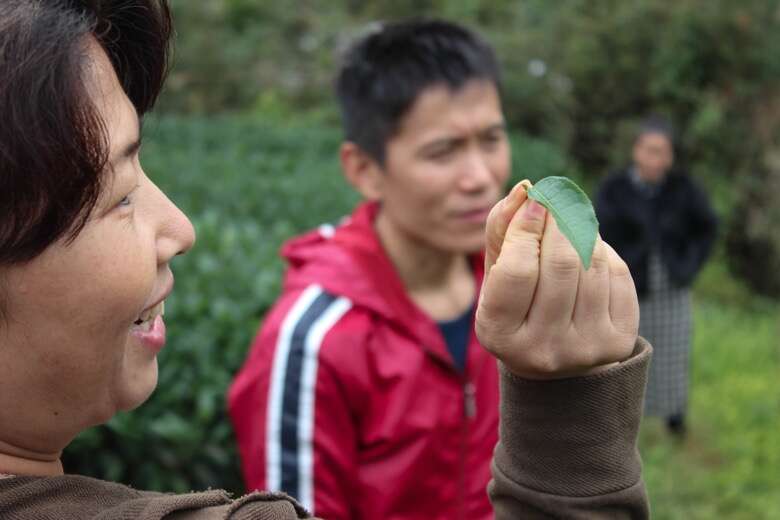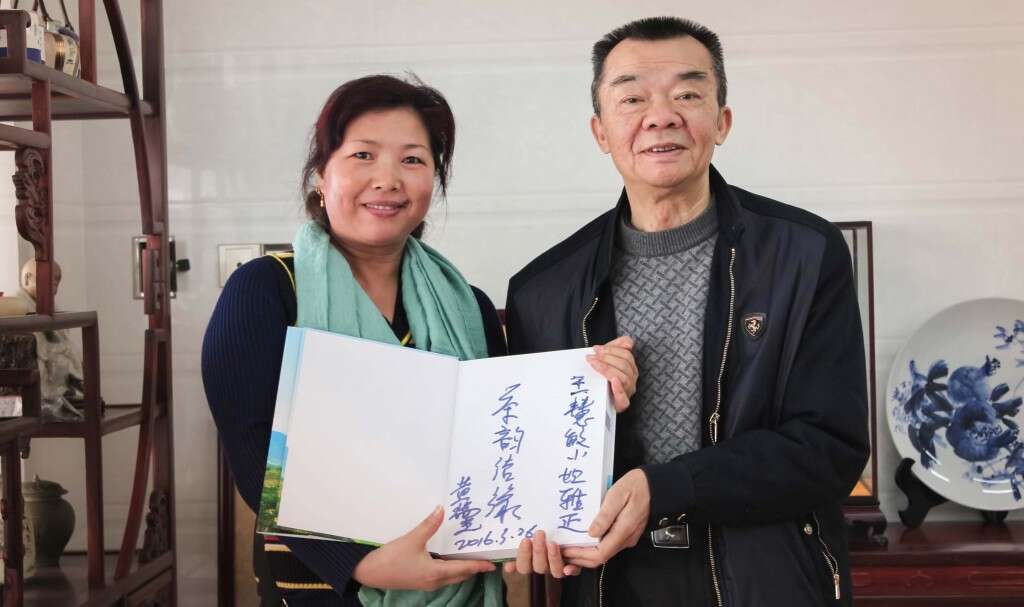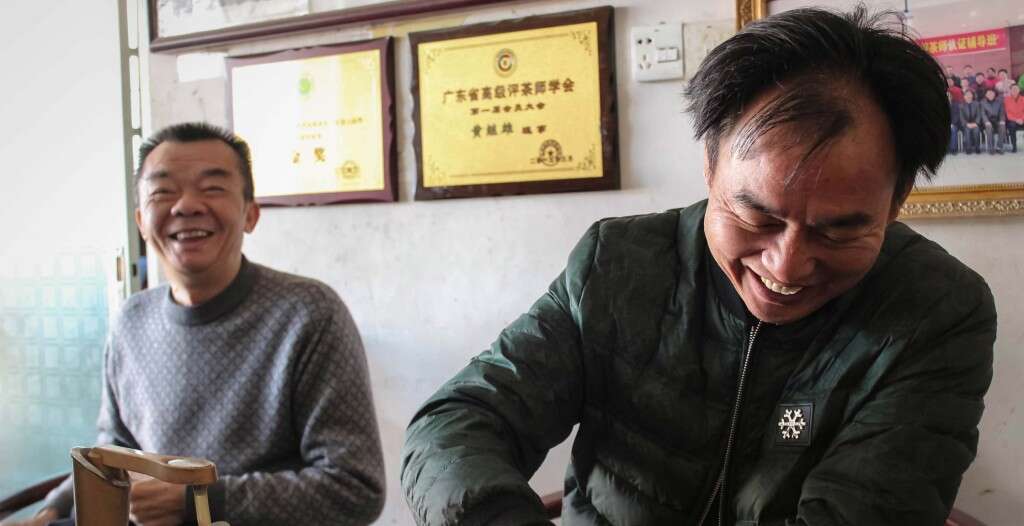Oolong craftsman, farmer, and teacher:
Master Zhang is one the most inspiring people we know.
While he has won countless awards for the quality of his tea over the last three decades, he only keeps one plaque in his office.
It is the one award not given by “professional” tasters and expo attendees, but by his neighbors and colleagues, given in recognition of his lifetime’s work to bring transparency and deep integrity to tea farming and oolong craft, recognizing him as a role model for the community and as the teacher that he is.
Even at the height of Tieguanyin’s meteoric rise in price and popularity in the early 2000’s, Master Zhang valued every harvest for its specific flavor profile, taste, texture and aroma – not just for the picking date or elevation.
Despite his vigilant work maintaining and monitoring organic standards for the region through biodiverse planting and use of canola as insect repellent and fertilizer, Master Zhang is reaching even further, working to repopulate the original forest cover and restore the wildlife habitat to pre-human levels so that his tea farming is truly zero-impact. He hopes to gain the first Original Ecological Preserve designation in the area and use it as a model for all of Anxi.
Every time we visit Master Zhang, we have our eyes opened to new farming techniques and unusual varietals of tea. Every time we taste tea together, he pulls out a new processing technique or a revival technique researched from the old records and oral tradition. That is why this year, when he called Wang Huimin – our partner in southern China – and invited her to observe the full oolong process from picking to finishing, she was on a bus early the next morning from Xiamen to Daping Village to catch the narrow window when tea was being harvested.


Wang Huimin is with us on many of our adventures across China. She has learned how to wild-forage and finish pu’er from thousand year old trees in the Mt Ailao National Forest Preserve. She has hand-finished Dancong with Master Huang in Fenghuang, studied white tea production and techniques in Fuding, and much more.


Having grown up in Fujian so close to Anxi, she loves to compare each region’s tea to Anxi Tieguanyin in terms of leaf size, requirements for cultivation, and processing. She has always held a certain pride in the overwhelming complexity and intensity of Tieguanyin production, and even moved to Qingdao for several years to try to introduce the tea of her homeland to northern China, where green tea and jasmine ruled at the time.
Every time she comes back from a new region, she loves to visit Master Zhang and share her stories of Wuyi black tea, Laoshan oolong, and even pu’er.
While tasting tea in his living room, she will ask Master Zhang if he has ever considered making green tea, white tea black tea or even strip style oolongs. He is always so deliberate in considering the techniques of other regions. He surprised us all once while Wang Huimin was joking about making Tieguanyin pu’er by telling us about the time he travelled to Yiwu to study pu’er with masters in the area. He told us that he wanted to see if he could learn anything from their techniques to bring back to Anxi.

Last year, Wang Huimin asked Master Zhang if she could move to Anxi and help him make oolong. She wanted to learn the process with the idea of applying Anxi oolong technique to teas like big leaf Qianjiazhai maocha.
Master Zhang smiled at her and said, “OK, next year come watch me make oolong and see what you think.”
True to his word, he called her up this spring one morning when he thought he would have the time and breath to explain his process as he worked, and when the weather would cooperate for a simpler withering step.
Wang Huimin was so excited she took a bus from Xiamen to Tong An that next morning and then caught a tiny rural connection bus all the way to Daping. The bus let her out in the middle of the small village, but she couldn’t remember the road. Knowing that Master Zhang was busy, she video-chatted us to ask directions and we helped remind her of the way up the mountain via 4G wireless.
When Wang Huimin arrived, it was just after lunch time, and she found Master Zhang hard at work with his colleagues in the plaza outside his new workshop monitoring the fresh leaves as they began to wither and lose moisture in the sun. They had come down from the mountains at 9AM with fresh leaves ready to spread and wither.
We got a tour of Master Zhang’s beautiful new workshop last year before it was completely finished, so Wang Huimin was excited to see the new space buzzing with activity, full of tea, neighbors, and equipment. Despite the size of the workshop, Master Zhang was still working in tiny batches. The first batch of the day only yielded about 10 pounds of finished tea.
After initial withering, Master Zhang showed Wang Huimin his special bamboo basket roller to start the yao qing or intentional bruising and shaking process. Rolling just a few pounds of tea at a time, Master Zhang checked the leaves continuously and when they reached a critical point, he took them out of the roller and spread them on flat bamboo tray to shake entirely by hand for a better feel and closer watch on the aromatics and color.
The leaves were allowed to rest between rounds of shaking and tumbling, long into the night. Wang Huimin started sending us pictures as night fell in the US, and was still sending clips long after our sunrise (their late night), still with plenty of time to go. By the end, she sounded more tired than Master Zhang just from watching!
After watching Dancong crafting with Huang Ruiguang, Wang Huimin was used to the idea that after shaking and tumbling, the rest would wrap up fairly quickly, just requiring heat (baking) and drying. Master Zhang had her up and still learning well into the second day, as shaking is just the beginning for Anxi oolong.
After he was satisfied with the aroma, Master Zhang put the leaves into a turning heater at 300 degrees celsius for 10 minutes to ‘fix’ them and prevent further oxidation. Wang Huimin said that even though she was super tired, the aroma when the leaves were heated was enough to get her excited and giddy. The florals that they had worked so hard to introduce through shaking permeated the entire workshop.
Next, Master Zhang used an alternating technique of rolling discs to begin curling the leaves, and stuffing the pliable leaves in a fabric bag and rolling the bag into a perfect ball.
This ball was rolled between discs to further encourage tighter ball shaped leaves before being opened and emptied to twist and roll the leaves loose. This process was alternated many times to further encourage the tight ball shape that Tieguanyin is known for. This extra step is unique to Tieguanyin and Wang Huimin thought the extra labor involved was remarkable.

After spending nearly 40 hours with Master Zhang following the process from start to finish, Wang Huimin tasted the results of their work with newfound appreciation.
For her, that first cup of finished tea was even more aromatic, even sweeter and even more beautiful in color than any she had tasted before. She shared short clips, pictures and narration of the whole process in the hopes that she can pass on the appreciation she gained from watching in person.
Master Zhang is too humble to emphasize how much labor he pours into every batch of tea, so Wang Huimin feels obligated to speak up for him and say that every cup is a labor of love, the work of a master craftsman.


 How To
How To Myths & Legends
Myths & Legends Travelogue
Travelogue Tasting Journal
Tasting Journal Talking Shop
Talking Shop Tea 101
Tea 101 Watch
Watch Teaware
Teaware News
News





























Leave a Reply